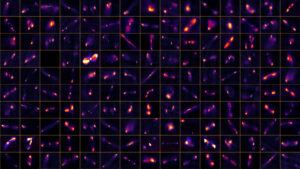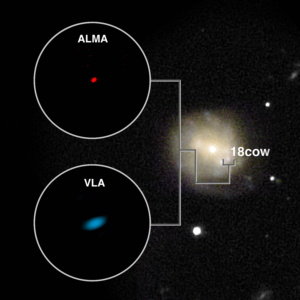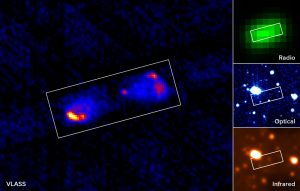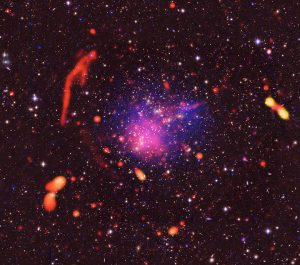There are 150 VLASS quicklook images in this compilation from the first part of our all-sky radio survey. Quicklook images are the first round of radio data downloaded from the survey that astronomers can use to identify the precise location of radio transients, measure magnetic fields in our galaxy and beyond, and study radio emission from galaxies and active galactic nuclei throughout the Universe, including regions hidden behind obscuring dust.


ALMA and VLA Images of AT2018cow
ALMA and VLA images of the mysterious new type of cosmic blast, AT2018cow at left. Visible-light image of outburst in its host galaxy at right. Images not to same scale. Images of the blast itself do not indicate its size, but are the result of its brightness and the characteristics of the telescopes.

Fanaroff-Riley 1 Radio Galaxy
Fanaroff-Riley 1 and 2 (FR-1 and FR-2) labels come from a classification system developed by B.L. Fanaroff and J.M. Riley that is used to identify radio galaxies with active galactic nuclei based on the brightness of their radio emissions. FR-1’s are radio sources whose luminosity decreases as the distance from the central galaxy host increases and can be signposts for galaxy clusters. FR-II’s are sources that exhibit increasing brightness in the outer lobes.

Orphan GRB Discovered with VLASS
Series of radio images of FIRST J1419+3940 from 1993 to 2017 show its slow fade. Astronomers comparing data from an ongoing major survey of the sky using the National Science Foundation’s Karl G. Jansky Very Large Array (VLA) to data from earlier surveys likely have made the first discovery of the afterglow of a powerful gamma ray burst that produced no gamma rays detectable at Earth. The unprecedented discovery of this “orphan” gamma ray burst (GRB) offers key clues to understanding the aftermath of these highly energetic events.

Sharper Image of Galaxy with VLASS
The sharpest radio view ever made of such a large portion of the sky! This galaxy, observed by the new VLA Sky Survey, resides near the constellation Draco in the northern hemisphere. No sources are detected at the radio galaxy’s position in optical wavelengths (center right panel), but there is a hint of the central galaxy at infrared wavelengths (bottom right panel). The top right panel shows the radio source from our previous (NVSS) survey, but the resolution was too faint to work out the details. However, our new survey has the resolution to reveal the distinct features of the radio lobes from a supermassive black hole found at the heart of most galaxies!

Radio Relics in Cluster Abell 2744
Multi wavelength composite astronomical image using data from the Jansky Very Large Array, Chandra X-ray Observatory, and optical data from the VLT and Subaru Telescopes.





